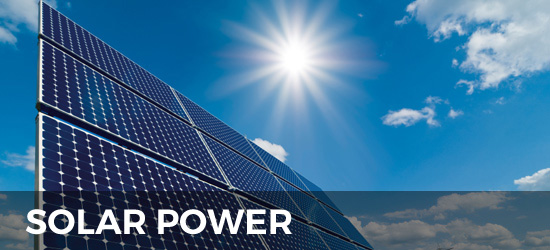
Frequently Asked Questions
Solar projects are set up mainly under three following policies in India:
National Solar Mission (JNNSM) - Target is to set 20,000 MW by the year 2022. It has been divided under 3 phases. Phase I is completed and Phase II, Batch I is under progress. Total of 750 MW has to be installed under Phase II, Batch I by April 28th, 2015. The draft guidelines for Phase II, Batch II for 1500 MW Solar Projects have also been released by MNRE. Under this scheme the project can be put anywhere in the country at a technically feasible site.
State Policies - the states across the country come out with their policies under reverse bidding or a fixed tariff scheme for setting up the projects. Eleven states have come out with their policies in the country so far which Includes Gujarat, Rajasthan, Punjab, U.P, A.P, M.P, Karnataka, T.N, Kerela, Odisha and Uttarakhand.
REC Mechanism - the Renewable Energy Certificate mechanism is the other way for setting solar projects anywhere across the country. The power a generator sells gives financial returns as per two components:
(i) APPC (Avg. Power Purchase/Pooled/Procurement Cost) - means the weighted average pooled price at which the distribution licensee has purchased electricity in the previous year from all the long-term energy suppliers excluding the purchases based on liquid fuel. Provided that the purchases from traders, short-term purchases and purchases from renewable sources shall not be taken into account while determining Pooled Cost of Power Purchase. It ranges from Rs. 2.3 to Rs.3.38 /kWh in India state wise.
RECs can also be availed in case of third party sale of power.
(ii) The REC Component -The price of RECs from year 2012-2017 is:
| Price per KWh or unit | Solar REC | Non Solar REC |
| Floor Price | Rs.9.3 | Rs.1.5 |
| Forbearance Price | Rs.13.4 | Rs.3.3 |
Suppose you set a Solar PV plant and a PPA (Power Purchase Agreement) of Rs.2.5/KWh (APPC) is signed with State utility. Then you can avail a minimum total tariff of Rs.11.8 per unit (APPC+ Solar Floor Price) provided all the RECs are traded at Power Exchange. The REC price is decided via price discovery mechanism as per demand and supply by power exchanges, which trade REC on last Wednesday of every month.
Further REC Info can be accessed at www.recregistryindia.nic.in
The land required for a 1 MW power plant setup is around 4-5 acres for Crystalline technology and around 6-7 acres for Thin-Film technology. This is only a rough benchmark and may vary based on technology and efficiency of panels. It also depends on the tilt angle at which Solar panels are placed, which depends on the location and geographical coordinates of the site.
The useful life of a typical Solar Power plant is considered to be 25 years. This is the duration for which long-term PPAs are signed and financial models are built. However, Solar Power plants can run beyond 25 years while producing a lower output. Many Solar Panel manufacturers guarantee an output of 90% at the end of 10 years and 80% at the end of 25 years.
The usual benchmark for energy generated from a 1 MW Solar Power plant is considered as 16,00,000 KWh annually. This is only a benchmark and should not be considered as the actual output for a given location. The amount of actual energy generated from a Solar Power Plant in a year depends on both internal and external factors. External factors which are beyond the control of a Solar developer are Number of sunny days, Solar Irradiation, Day Temperatures, Air Mass etc.
The output also depends on the following internal factors all of which are within the control of a Solar Developer:
- Plant Location
- Usage of Solar Tracking systems
- Quality of equipment used
- Workmanship of the EPC contractor
- O&M activities
The various modes under which a Solar Power plant can be setup depends on the specific requirement. All the following are valid modes and the costs for each kind of system varies based on various factors:
- Off-Grid Captive Consumption for domestic premises
- Off-Grid Captive Consumption for commercial premises
- Grid Connected (Net Metered) Captive Consumption for domestic premises
- Grid Connected (Net Metered) Captive Consumption for commercial premises
- Sale of Power generated to local Distribution Company (DISCOM)
- Sale of Power generated to 3rd Party consumer (Industry or Commercial entity)
What is the cost of setting up a Rooftop Solar Power plant for domestic or commercial use?
Rooftop Solar Power plants can be broadly categorized into Battery-based and Non-Battery based systems. The benchmark cost set by MNRE for the year 2013-14 for these systems are:
Systems without battery backup:
(i) For projects up to 100kWp- Rs.100 per Watt peak
(ii) For projects above 100kWp and up to 500 kWp- Rs.90 per Watt peak.
Systems with 6 hrs battery backup:
(i)For up to 1 kWp-Rs.210 per Watt peak
(ii) For above 1 kWp and up to 10 kWp- Rs.190 per Watt peak
(iii) For above 10 kWp and up to 100 kWp- Rs.170 per Watt peak.
More details can be accessed on the following MNREwebpage
Identifying the Solar Power plant size for your domestic or commercial premises depends on the following factors:
- Wattage of appliances to be run on Solar
- Monthly energy consumption from these appliances
- Energy Backup or Days of Autonomy required
- Roof space available for plant setup
Based on these factors, the power plant sizing can be accordingly done at your end.
Total project cost per MW would be in the range of Rs.4.8 Crores-Rs.5.8 Crores depending on the kind of technology you are using, whether or not you are using tracking systems, the kind of EPC Contractor you choose for power plant system etc. CERC recently announced the benchmark tariff for setup of Solar PV and Thermal Plants in India. Here’s the link to the document containing more details: www.cercind.gov.in
The table below indicates Project cost for the Financial Year 2015-16.
| S.No | Components | Capital Cost Proposal Lac/MW |
|---|---|---|
| Module Cost in USD/Wp | 0.33 | |
| Exchange rate in /USD @ average of last six months | 65.00 | |
| 1 | Module Cost Lakhs / MW | 215.00 |
| 2 | Degradation in Lakhs / MW | 10.00 |
| 3 | Land Leveling and Fencing Cost | 10.00 |
| 4 | Civil and General Works | 20.00 |
| 5 | Mounting Structure | 40.00 |
| 6 | Power Conditioning Unit | 40.00 |
| 7 | Cables & Transformers | 60.00 |
| 8 | Preliminary & Operating Expenses, IDC etc., | 60.00 |
| Total Capital Cost | 455.00 |
Central Electricity Regulatory Commission (CERC) benchmark costs for O&M is Rs.11.63 lakhs/year/MW for 2013-14 with a 5.72% increase every year. This varies from project to project based on the number of people you employ for maintenance, frequency of cleaning of panels, onsite-engineer availability etc.
As per the Second Amendment of REC Principal Regulations – 2013, there is no lower limit for Solar Power plants to be eligible for RECs. Though it previously stated that 250 KW is the minimum size for Solar Power plants to be eligible for RECs, the same has been removed as part of the above stated amendment.
Yes. REC Mechanism and CDM are mutually exclusive and hence a power developer can claim CDM benefits (Carbon Credits) also. However, it is to be noted that the current trading prices of Carbon Credits or Certified Emission Reductions (CERs) at the European ETS system is less than 0.7 Euro which are pretty low compared to the 15-20 Euro trading prices a few years back. At these prices, getting a Solar project registered under CDM mechanism does not make any sense as the payback for the expenses in the process itself takes several years. Unless the Solar Power Plant is of size 10 MW or more it does not make financial sense to go for Carbon Credits (CERs).
Solar plants can be categorized into 2 broad categories – Grid Connected and Off-Grid plants. The usual Govt. support available for an Off-Grid plant is a Capital Subsidy of 30% on the project cost up to a maximum size of 500 KW. This can be claimed by the Manufacturer/Supplier/EPC Contractor (should be an MNRE accredited supplier) on behalf of the customer. The list of MNRE accredited suppliers (all across India) can be downloaded from www.mnre.gov.in
Subsidy is not available for Grid Connected plants that engage in sale of power either to the local DISCOM or a 3rd party. Following are the benefits a Solar Power Developer involved in Sale of Power Generated can avail:
- Accelerated Depreciation – Upto 90% of asset value with 80% depreciation allowed in the first year.
- 10 years Tax Holiday – Tax holiday can be availed for 10 years during which time Minimum Alternate Tax is still applicable (20%) which can be offset against tax payable later.
- Other State specific exemptions which vary from state to state.
Yes. Accelerated Depreciation benefits can be claimed by Off-Grid and Grid-Connected Solar Power Developers in order to offset taxes on profits from their connected businesses. Typically, 90% depreciation is allowed with 80% allowed in the first year.
Capital Subsidy cannot be claimed for plants beyond 500 KW size with not more than 100 KW of installation on a single roof. Also, capital subsidy is made available only to Off-Grid and Decentralized Solar Power plants and not Grid Connected Plants that are in the business of selling the generated power. Subsidy of up to 90% is available in some north eastern and other hilly states in case of govt. buildings.




